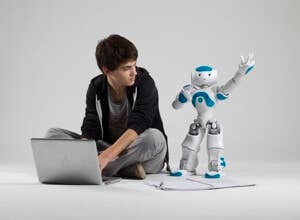The NAO Humanoid Robot Gets Slimmer And Smarter With NAO Next Gen (video)

Share
The next generation of our favorite two-foot, programmable, French robot, NAO, has just been released by Aldebaran Robotics. NAO Next Gen is not only smarter and more physically stable, but increased versatility means the 2,000 or so NAO programmers around the world will have more flexibility in pushing the boundaries of what NAO can do.
Probably the most significant addition to Next Gen is its new on-board computer. Based on Intel’s 1.6GHz AtomTM, the new processor will allow NAO Next Gen to multi-task like never before. It also got a pair of high-definition cameras to replace the old ones. The cameras are connected to a field-programmable gate array (FPGA) – a programmable microchip – which allows for the visual feeds to be received simultaneously. NAO can process visual information faster with the chip and recognize faces and objects better even under low light conditions. Object tracking is better now too, involving the entire body rather than just the head and allowing for greater tracking range.
NAO Next Gen’s hearing capabilities are also improved. It now uses Nuance speech recognition. We’re still a ways away from robots understanding entire sentences, but with a “word spotting” feature NAO can pick out key words and make an educated guess as to what’s being asked of it. The four microphones allow for improved sound location, and when it follows the sound it walks with a much smoother gait.
As you’ll see in the video, NAO Next Gen just got better at protecting all that sophisticated hardware. When it’s knocked over – it will have to work with clumsy humans someday – an internal sensor triggers a fall manager program. It swiftly raises its arms – which, by the way are thinner and longer – to break its fall.
Be Part of the Future
Sign up to receive top stories about groundbreaking technologies and visionary thinkers from SingularityHub.


Aldebaran's improved Choreographe software allows developers to program NAO's movements in simple and intuitive ways. It's an impressive robot, and we can expect more great things to come. As Aldebaran founder Bruno Masonnier said in a press release, “On top of this new hardware version, we shall be delivering new software functionalities like smart torque control, a system to prevent limb/body collisions, an improved walking algorithm, and more.”
In the press release Aldebaran refers to itself as “the world leader in humanoid robotics.” While there’s no arguing they are a world leader, I think Honda’s Asimo might have something to say about whether the world’s best humanoid robot is in Japan or France. Just like NAO, Asimo recently got slimmer and smarter. Regardless, it’s going to be exciting to see what the NAO Developer community produces in the coming year as Next Gen is shipped out to labs all over the world. And if you’re like me, you’re eagerly waiting the day when average Joes like us can get our hands on a NAO. They haven’t given a price for the Next Gen yet, but NAOs in the past typically run developers about $15K. And then there’s the part about having to be a researcher. So I guess we’ll have to give it some more time. But can you imagine what NAO’s going to look like, going to be capable of in a few years? How about ten years? When it’s finally ready for you and I to take home, it will surely be an amazing addition to the household.
[image credits: Aldebaran Robotics]
[video credit: Aldebaran Robotics via YouTube]
images: NAO Next Gen
video: NAO Next Gen
Peter Murray was born in Boston in 1973. He earned a PhD in neuroscience at the University of Maryland, Baltimore studying gene expression in the neocortex. Following his dissertation work he spent three years as a post-doctoral fellow at the same university studying brain mechanisms of pain and motor control. He completed a collection of short stories in 2010 and has been writing for Singularity Hub since March 2011.
Related Articles

These Robots Are the Size of Single Cells and Cost Just a Penny Apiece

Hugging Face Says AI Models With Reasoning Use 30x More Energy on Average

Study: AI Chatbots Choose Friends Just Like Humans Do
What we’re reading
